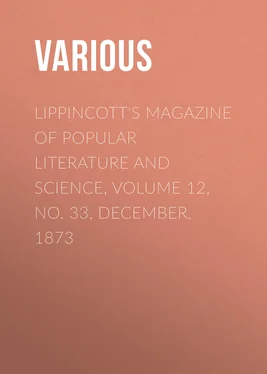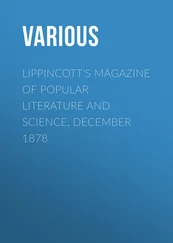Various - Lippincott's Magazine of Popular Literature and Science, Volume 12, No. 33, December, 1873
Здесь есть возможность читать онлайн «Various - Lippincott's Magazine of Popular Literature and Science, Volume 12, No. 33, December, 1873» — ознакомительный отрывок электронной книги совершенно бесплатно, а после прочтения отрывка купить полную версию. В некоторых случаях можно слушать аудио, скачать через торрент в формате fb2 и присутствует краткое содержание. Издательство: Иностранный паблик, Жанр: foreign_antique, periodic, foreign_edu, на английском языке. Описание произведения, (предисловие) а так же отзывы посетителей доступны на портале библиотеки ЛибКат.
- Название:Lippincott's Magazine of Popular Literature and Science, Volume 12, No. 33, December, 1873
- Автор:
- Издательство:Иностранный паблик
- Жанр:
- Год:неизвестен
- ISBN:нет данных
- Рейтинг книги:5 / 5. Голосов: 1
-
Избранное:Добавить в избранное
- Отзывы:
-
Ваша оценка:
- 100
- 1
- 2
- 3
- 4
- 5
Lippincott's Magazine of Popular Literature and Science, Volume 12, No. 33, December, 1873: краткое содержание, описание и аннотация
Предлагаем к чтению аннотацию, описание, краткое содержание или предисловие (зависит от того, что написал сам автор книги «Lippincott's Magazine of Popular Literature and Science, Volume 12, No. 33, December, 1873»). Если вы не нашли необходимую информацию о книге — напишите в комментариях, мы постараемся отыскать её.
Lippincott's Magazine of Popular Literature and Science, Volume 12, No. 33, December, 1873 — читать онлайн ознакомительный отрывок
Ниже представлен текст книги, разбитый по страницам. Система сохранения места последней прочитанной страницы, позволяет с удобством читать онлайн бесплатно книгу «Lippincott's Magazine of Popular Literature and Science, Volume 12, No. 33, December, 1873», без необходимости каждый раз заново искать на чём Вы остановились. Поставьте закладку, и сможете в любой момент перейти на страницу, на которой закончили чтение.
Интервал:
Закладка:
The mar of earth and canker-worm
The foliage bears;
So my poor life of sin and care
The impress wears.
As shine the leaves before they fall
With brighter hue,
And each defect of worm and time
Is lost to view,
So may my life, when fading, shine
With brighter ray,
And brighter still as nearer to
The perfect day.
And as new life still springs again
From fallen leaves,
And richer life a thousand-fold
From gathered sheaves;
So, God, if aught in me was good,
The good repeat,
And let me from my ashes breathe
An influence sweet.
SKETCHES OF EASTERN TRAVEL
III.—BANGKOK
We left Singapore—which, though an English colony, is a very Babel of languages and nations—in a Bombay merchantman, whose captain was an Arab, the cook Chinese, and the fourteen men who composed the crew belonged to at least half that many different nations, whilst our party in the cabin were English, Scotch, French and American. After eight days of rather stormy weather we disembarked at the mouth of the Meinam River, thirty miles below the city of Bangkok. Owing to the sandbar at the mouth, large vessels must either partially unload outside, or wait for the flood-tide when the moon is full to pass the bar; and to avoid the delay consequent upon either course, we took passage for the city in a native sampan pulled by eight men with long slender oars. The trip was a delightful one, giving us enchanting glimpses of the grand old city long before we reached it. Amid the mass of tropical foliage, gleaming out from among clustering palms and graceful banians, we could discern the gilded spires of gorgeous temples and palaces, of which Bangkok boasts probably not less than two hundred. The temples, with their glittering tiles of green and gold, and graceful turrets and pinnacles from which hang tiny tinkling bells that ring out sweet music with every passing breeze, their tall, slender pagodas and picturesque monasteries, stand all along the banks of the river, its most conspicuous adornments. But pre-eminent, both for height and splendor, is Wat Chang, visible, all but its base, from the very mouth of the river. Its central spire, full three hundred feet in height, towers grandly above the surrounding turrets and pagodas, the white walls gleaming out from the dark foliage of the banian, and the feathery fringes of the palm reflected on its shining roof.
The two main entrances to the royal palace are of white masonry very elaborately adorned. Groups of elegant columns support a capital composed of nine crowns rising one above the other, and terminating in a slender spire of some forty feet. The whole is inlaid in exquisite mosaics of porcelain, the various colors arranged in quaint devices, so as to produce the happiest effect, while the reflection of the sun's rays upon the glazed tiles, the numberless turrets and pinnacles of the lofty pile, and the porticoes and balconies of pure white marble opening from every window, and leading to delectable conservatories, luxurious baths or fairy groves and arbors, present, as grouped together, a sight worth a trip across the waters to enjoy. The engraving represents one of these entrances, and His Majesty Somdetch Phra Paramendr Maha Mongkut, the late supreme king of Siam, on his return from his usual afternoon promenade. This "promenade," however, was not a walk, a ride or a drive, but an airing in one of the royal state barges. For the late king, true to the usages of his forefathers, continued to the very close of his life to make all his tours, public and private, with very rare exceptions, by water. This has heretofore been the custom of all classes, the gently-flowing Meinam being the Broadway of Bangkok, and canals, intersecting the city in every direction, its cross streets. Every family keeps one or more boats and a full complement of rowers; palaces and temples have their gates on the river; and upon its placid waters move in ever-varying panorama life's shifting scenes of weddings and funerals, business and pleasure, from early morn till long past midnight. Only since the accession of the present kings have streets been constructed along the river-banks; and these young princes, as a sort of concession to European customs, now take occasional drives in open carriages, attended by liveried servants, though for state processions boats are still in vogue. His Majesty the late king was ordinarily conveyed to the jetty in a state palanquin, and handed from it into his boat, without the sole of his boot ever touching the ground. This has been the custom of Siamese monarchs from time immemorial, but I have sometimes seen both the late kings wave aside their bearers and jump with agile dexterity into their boats, as if it were a relief to them to lay aside courtly etiquette and act like ordinary mortals. The royal palanquins are completely covered with plates of pure gold inlaid with pearls, and the cushions are of velvet embroidered, and edged with heavy gold lace. They are borne by sixteen men robed in azure silk sarangs and shirts of embroidered muslin. The umbrella is of blue, crimson or purple silk, and for state occasions is richly embroidered, and studded with precious stones. So also are those placed over the throne, the sofa, or whatever seat the king happens to occupy.
The late supreme king, who died in 1868 at the age of sixty-five, was tall and slender in person, of intellectual countenance and noble, commanding presence. His ordinary dress was of heavy, dark silk, richly embroidered, with the occasional addition of a military coat. He wore also the decorations of several orders, and a crown—not the large one, which is worn but once in a lifetime, and that on the coronation-day—but the one for regular use, which is of fine gold, conical in shape and the rim completely surrounded by a circlet of magnificent diamonds. This prince, the most illustrious of all the kings of Siam, spent many of the best years of his life in the priesthood as high priest of the kingdom. He was a profound scholar, not only in Oriental lore, but in many European tongues and in the sciences. In public he was rather reticent, but in the retirement of the social circle and among his European friends the real symmetry of his noble character was fully displayed, winning not only the reverence but the warm affection of all who knew him. He died universally regretted, and the young prince now reigning as supreme king is his eldest surviving son: the second king is his nephew.
Among the choice treasures of Siam are her elephants, but they belong exclusively to the Crown, and may be employed only at the royal command. They are used in state processions and in traveling by the king and members of the royal family, and in war at the king's mandate only. It is death for a Siamese subject, unbidden by his sovereign, to mount one of His Majesty's elephants. In war they are considered very effective, their immense size and weight alone rendering them exceedingly destructive in trampling down and crushing foot-soldiers. The howdah is placed well up on the animal's back, and in it sits a military officer of high rank, with an iron helmet on his head, and above him a seven-layered umbrella, as the insignia of his royal commission. On the croup sits the groom, guiding the royal beast with an iron hook, while all about the officer are disposed lances, javelins, pikes, helmets and other munitions of war, which he dispenses as they are needed during the progress of a battle. I have been told that as many as six or seven hundred of these colossal creatures are often marched and marshaled in battle together; and so perfectly are they trained as to be guided and controlled without difficulty, even amid the din of firearms and the conflict of contending armies. Sometimes on the king's journeys into the interior a train of fifty or sixty will be marched in perfect order, their stately stepping beautiful to behold, but their huge feet coming down with a jolt that threatens to dislocate every joint of the unfortunate rider.
Читать дальшеИнтервал:
Закладка:
Похожие книги на «Lippincott's Magazine of Popular Literature and Science, Volume 12, No. 33, December, 1873»
Представляем Вашему вниманию похожие книги на «Lippincott's Magazine of Popular Literature and Science, Volume 12, No. 33, December, 1873» списком для выбора. Мы отобрали схожую по названию и смыслу литературу в надежде предоставить читателям больше вариантов отыскать новые, интересные, ещё непрочитанные произведения.
Обсуждение, отзывы о книге «Lippincott's Magazine of Popular Literature and Science, Volume 12, No. 33, December, 1873» и просто собственные мнения читателей. Оставьте ваши комментарии, напишите, что Вы думаете о произведении, его смысле или главных героях. Укажите что конкретно понравилось, а что нет, и почему Вы так считаете.












